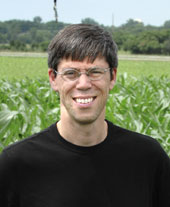AMES, Iowa -- Mapping the corn genome, says Patrick Schnable, director of the Center for Plant Genomics, "is similar to Lewis and Clark exploring the Louisiana Purchase.
"President Jefferson had bought all this land west of the Mississippi and needed to know what was there and how to use it."
Explaining possible uses of the corn genome map, other genomes and the future of genome research are the subject of Schnable's Spring 2008 Presidential University Lecture "Exploring Crop Genomes, Advancing Crop Improvement" at 8 p.m., March 31, in the Sun Room, Memorial Union. The event is free and open to the public.
Schnable is a participant in the Maize Genome Sequencing Consortium, which presented some of its findings at the 50th Annual Maize Genetics Conference in Washington, D.C., last month. Srinvias Aluru, a professor in electrical and computer engineering department, is the other ISU faculty participant in the Maize Genome Sequencing Consortium.
"In addition to enabling the genetic improvement of crops and livestock, genome sequencing projects are having enormous impacts on many other disciplines including basic biology, economics, policy, climate change and human nutrition", Schnable said.
In the future, Schnable sees mapping genomes as being more commonplace.
Right now there is "revolutionary sequencing technology that will map genomes faster and cost 10 percent of what it now costs," said Schnable. Iowa State is in line to purchase the new technology, he added.
To provide a sense of the impact these technologies will have on science, Schnable related the sequencing of the genome of an extinct animal.
"Scientists in Siberia have discovered carcasses of wooly mammoths (relatives of elephants) that have been frozen for over 10,000 years," he says. "Using one of the new sequencing technologies it was possible to sequence the genome of one of these extinct animals. In addition, by sequencing the genes associated with a mammoth's tooth it was possible to determine which plants and microbes the animal had eaten just prior to its death. So this genome sequencing project provided information about which other species were alive at the time of the mammoth's death."
Schnable is associate director of the Plant Sciences Institute, director of the Center for Plant Genomics, director of the newly formed Center for Carbon Capturing Crops, Baker Professor of Agronomy and holds appointments in Agronomy and Genetics, Development and Cell Biology.
ISU President Gregory Geoffroy created the Presidential University Lecture Series in 2003 to highlight the expertise and excellence of Iowa State faculty.
This lecture is co-sponsored by the Miller Endowment, Office of the President and the Committee on Lectures which is funded by the Government of the Student Body
